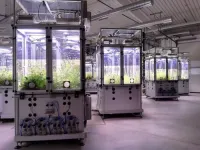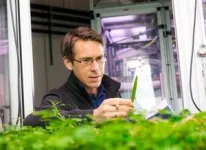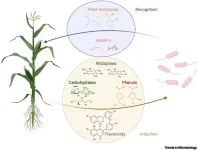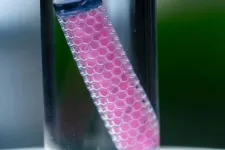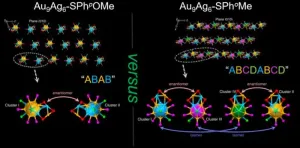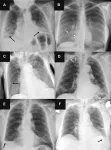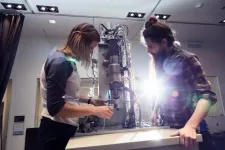(Press-News.org) Leipzig. The decline in invertebrates also affects the functioning of ecosystems, including two critical ecosystem services: aboveground pest control and belowground decomposition of organic material, according to a new study published in Current Biology and led by researchers at the German Centre for Integrative Biodiversity Research (iDiv) and Leipzig University. The study provides evidence that loss of invertebrates leads to a reduction in important ecosystem services and to the decoupling of ecosystem processes, making immediate protection measures necessary.
Invertebrates, such as insects and also other arthropods, snails, slugs and nematodes, represent ~75% of all species described on Earth and are a fundamental part of ecosystems, providing many critical ecosystem functions and services, such as pollination, decomposition, and natural pest control. Human-caused environmental changes, in particular land-use change, landscape simplification, and urbanization, including habitat loss and chemical pollution, have been driving the global decline of invertebrates in recent decades. However, measuring the potential effect of this loss has so far proven difficult. “The manipulation of aboveground invertebrate communities has been a major challenge in ecological research, because of their functional diversity and mobility”, explains Nico Eisenhauer, lead author and professor for Experimental Interaction Ecology at iDiv and Leipzig University.
A team of researchers used the iDiv Ecotron, a joint research platform of iDiv and the Helmholtz Centre for Environmental Research (UFZ). It consists of several controlled mini-ecosystems (so-called EcoUnits), to study the effects of these complex communities. “Apart from offering a bridge between small-scale experiments under highly controlled conditions and less controllable large-scale field experiments or monitoring programs, the goal of the iDiv Ecotron was to enable experiments manipulating biodiversity changes at different levels of food webs in above- and belowground ecosystem compartments”, says iDiv Honorary Member Francois Buscot, professor emeritus at Leipzig University and former head of the UFZ department for Soil Ecology.
The researchers simulated and tested how various ecosystem services and plant diversity respond in 24 distinct grassland ecosystems across three levels of aboveground invertebrate biomass (100%, 36%, and 0%). A biomass level of 36% reflects the dramatic decline of invertebrates reported across German grasslands in the last decade. All plant and invertebrate species were collected from the same adjacent hay meadow, and the researchers simulated the natural turnover of aboveground invertebrate communities by exchanging invertebrate communities three times from May until November 2018. “I am particularly excited about this simulation of the phenology of invertebrate communities - something that has, to my knowledge, not been done before”, Nico Eisenhauer, head of the iDiv Ecotron, adds.
The researchers found that as the biomass of invertebrates decreases, so does the number of ecosystem services. For example, aboveground invertebrates play an important role in natural pest control. The researchers observed that declines in invertebrates went hand in hand with aphid outbreaks indicating that pest outbreaks may be a widespread consequence of biodiversity loss at higher trophic levels, with significant cascading effects on crop production and other ecosystem services.
Further, loss of aboveground invertebrates led to a significant reduction in belowground decomposition. “Aboveground and belowground processes are connected by invertebrates that consume plants and leaf litter. Loss of those connections will change nutrient cycling and how much carbon can be sequestered in ecosystems," explains Ecotron coordinator Dr Jes Hines from iDiv and Leipzig University.
The amount of invertebrate biomass also affected the plants that were growing in the experimental grassland ecosystems. Aboveground plant biomass increased in the EcoUnits with reduced invertebrate biomass. This could be because invertebrates usually eat more of the plant aboveground. “This way, energy is channeled up from plants to higher trophic levels in intact invertebrate communities”, explains Jes Hines. The researchers also found that the concentration of carbon and nitrogen in plant tissue significantly decreased, which, in turn, may alter the quality of resources and nutrients fueling biological activity in soils.
“In a healthy ecosystem, biotic and biogeochemical properties are coupled. This study shows that a decrease in aboveground invertebrate biomass reduces this coupling, which might threaten species diversity, as well as animal, plant, and microbial nutrition”, says Nico Eisenhauer. Despite these alarming findings, ecosystems may recover following legislative changes that favor invertebrate diversity. For example, there is evidence of freshwater insect populations increasing following the Clean Water Act. Immediate protection measures stand to turn the tide on safeguarding diverse invertebrate communities and important ecosystem functions.
END
Invertebrate decline reduces natural pest control and decomposition of organic matter
Immediate protection measures are required to safeguard invertebrate communities and critical ecosystem services.
2023-09-26
ELSE PRESS RELEASES FROM THIS DATE:
Genetically engineering associations between plants and nitrogen-fixing microbes could lessen dependence on synthetic fertilizer
2023-09-26
Nitrogen is an essential nutrient for plant growth, but the overuse of synthetic nitrogen fertilizers in agriculture is not sustainable. In a review article publishing in the journal Trends in Microbiology on September 26, a team of bacteriologists and plant scientists discuss the possibility of using genetic engineering to facilitate mutualistic relationships between plants and nitrogen-fixing microbes called “diazotrophs.” These engineered associations would help crops acquire nitrogen from the air by mimicking the mutualisms between legumes and nitrogen-fixing bacteria.
“Engineering associative diazotrophs to provide nitrogen ...
Impact of parental relatedness on type 2 diabetes and other common diseases uncovered
2023-09-26
A new study finds that consanguinity – unions between close relatives - may increase the risk of common diseases such as type 2 diabetes and post-traumatic stress disorder (PTSD).
Researchers from the Wellcome Sanger Institute and their collaborators at Queen Mary University of London analysed the genomic data of diverse groups to investigate the relationship between autozygosity - a measure of genetic relatedness between an individual’s parents - and the prevalence of common diseases, with a novel method that reduces confounding due to sociocultural factors. They focused ...
Redefining global health security: A novel framework sheds light on equity and decolonial approaches
2023-09-26
Redefining Global Health Security: A Novel Framework Sheds Light on Equity and Decolonial Approaches
Kuala Lumpur, Malaysia and London, UK – 25 September 2023
In the wake of the COVID-19 pandemic, a new policy paper titled "Global Health Security and the Health-Security Nexus: Principles, Politics and Praxis" in the journal BMJ Global Health, warns of dangers and potential pitfalls associated with the increased attention paid to ‘global health security’ and the growing interaction between public health and security actors.
According to the authors, the prevailing ...
Inbreeding can be beneficial in the long run
2023-09-26
"Of all the subspecies of reindeer found in the high north, the Svalbard reindeer has the most inbreeding and the lowest genetic diversity," says Nicolas Dussex, a postdoc at Norwegian University of Science and Technology´s (NTNU) Department of Natural History.
It was only 7000-8000 years ago that the first reindeer migrated to Svalbard, most likely from Russia via Novaya Zemlya and the islands of Franz Josef Land. Perhaps there were no more than a few animals that established themselves on the arctic ...
Feds fund research that could slash US cancer deaths by 50%
2023-09-26
HOUSTON – (Sept. 26, 2023) – The Advanced Research Projects Agency for Health (ARPA-H) has awarded $45 million to rapidly develop sense-and-respond implant technology that could slash U.S. cancer-related deaths by more than 50%.
The award to a Rice University-led team of researchers from seven states will fast-track development and testing of a new approach to cancer treatment that aims to dramatically improve immunotherapy outcomes for patients with ovarian, pancreatic and other difficult-to-treat cancers.
“Instead of tethering patients to hospital beds, IV bags and external monitors, ...
Thiol ligands modify metal nanocluster structures and optical properties
2023-09-26
Metal nanoclusters are tiny, crystalline structures up to two nanometers (2 x 10-9 meters) in diameter that contain a few to hundreds of metal atoms. Understanding the precise assembly of metal nanoclusters is paramount to determining how different structures affect the properties and molecular interactions of these materials. Researchers recently synthesized two similar gold-silver (Au9Ag6) nanoclusters in a highly controlled manner to determine the precise atomic structure of each nanocluster and the effects of specific thiol ligands, or sulfur-containing binding molecules, on material synthesis.
Given their extremely small size, metal nanoclusters have ...
Researchers build and test a framework for achieving climate resilience across diverse fisheries
2023-09-26
(Santa Barbara, Calif.) — What makes for a successful climate-resilient fishery, one that sustainably produces resources for human benefit despite increasing climate stressors and human impacts? It’s a question that faces present and future fisheries, their practitioners and fishing communities as the world turns to the ocean to feed its growing population.
“For a fishery to be resilient it needs to be able to prepare for, resist, cope with, recover from, or adapt to any given impact,” said Jacob Eurich, who is a research associate at UC Santa Barbara’s Marine Science Institute, and a fisheries scientist at the Environmental Defense Fund (EDF). “In ...
Radiologists outperformed AI in identifying lung diseases on chest X-ray
2023-09-26
OAK BROOK, Ill. – In a study of more than 2,000 chest X-rays, radiologists outperformed AI in accurately identifying the presence and absence of three common lung diseases, according to a study published in Radiology, a journal of the Radiological Society of North America (RSNA).
“Chest radiography is a common diagnostic tool, but significant training and experience is required to interpret exams correctly,” said lead researcher Louis L. Plesner, M.D., resident radiologist and Ph.D. fellow in the Department of Radiology at Herlev and Gentofte Hospital in Copenhagen, Denmark.
While commercially available ...
SwRI, UTSA collaborate to detect traumatic brain injury through breath analysis
2023-09-26
SAN ANTONIO — September 26, 2023—Researchers from Southwest Research Institute (SwRI) and The University of Texas at San Antonio (UTSA) are developing techniques to detect traumatic brain injury (TBI) by analyzing breath for specific biomarkers. The project, led by SwRI’s Dr. Mark Libardoni and UTSA’s Dr. Marzieh Memar and Dr. Morteza Seidi, is supported by a $125,000 grant from the Connecting through Research Partnerships (Connect) program.
Breath analysis is performed by analyzing exhaled breath for specific biomarkers, such as metabolites, proteins and ...
Projects launch to map brain connections in mouse and macaque
2023-09-26
A complete map of all the connections in an entire mammalian brain may be in sight. Allen Institute researchers have just launched three new projects to construct large, detailed maps of neuronal connections in sections of the mouse and macaque brains, with an eye toward creating full wiring diagrams of these animals’ brains in the future. These projects are funded by the National Institutes of Health’s Brain Research Through Advancing Innovative Neurotechnologies® (BRAIN) Initiative.
Allen Institute research teams ...
LAST 30 PRESS RELEASES:
Tracing the quick synthesis of an industrially important catalyst
New software sheds light on cancer’s hidden genetic networks
UT Health San Antonio awarded $3 million in CPRIT grants to bolster cancer research and prevention efforts in South Texas
Third symposium spotlights global challenge of new contaminants in China’s fight against pollution
From straw to soil harmony: International team reveals how biochar supercharges carbon-smart farming
Myeloma: How AI is redrawing the map of cancer care
Manhattan E. Charurat, Ph.D., MHS invested as the Homer and Martha Gudelsky Distinguished Professor in Medicine at the University of Maryland School of Medicine
Insilico Medicine’s Pharma.AI Q4 Winter Launch Recap: Revolutionizing drug discovery with cutting-edge AI innovations, accelerating the path to pharmaceutical superintelligence
Nanoplastics have diet-dependent impacts on digestive system health
Brain neuron death occurs throughout life and increases with age, a natural human protein drug may halt neuron death in Alzheimer’s disease
SPIE and CLP announce the recipients of the 2025 Advanced Photonics Young Innovator Award
Lessons from the Caldor Fire’s Christmas Valley ‘Miracle’
Ant societies rose by trading individual protection for collective power
Research reveals how ancient viral DNA shapes early embryonic development
A molecular gatekeeper that controls protein synthesis
New ‘cloaking device’ concept to shield sensitive tech from magnetic fields
Researchers show impact of mountain building and climate change on alpine biodiversity
Study models the transition from Neanderthals to modern humans in Europe
University of Phoenix College of Doctoral Studies releases white paper on AI-driven skilling to reduce burnout and restore worker autonomy
AIs fail at the game of visual “telephone”
The levers for a sustainable food system
Potential changes in US homelessness by ending federal support for housing first programs
Vulnerability of large language models to prompt injection when providing medical advice
Researchers develop new system for high-energy-density, long-life, multi-electron transfer bromine-based flow batteries
Ending federal support for housing first programs could increase U.S. homelessness by 5% in one year, new JAMA study finds
New research uncovers molecular ‘safety switch’ shielding cancers from immune attack
Bacteria resisting viral infection can still sink carbon to ocean floor
Younger biological age may increase depression risk in older women during COVID-19
Bharat Innovates 2026 National Basecamp Showcases India’s Most Promising Deep-Tech Ventures
Here’s what determines whether your income level rises or falls
[Press-News.org] Invertebrate decline reduces natural pest control and decomposition of organic matterImmediate protection measures are required to safeguard invertebrate communities and critical ecosystem services.
